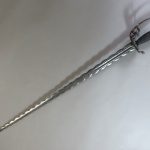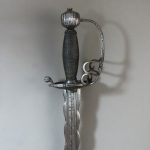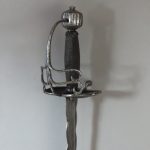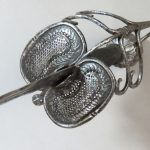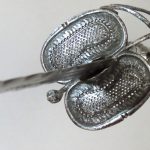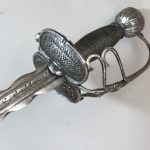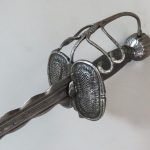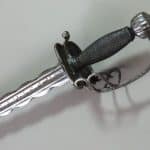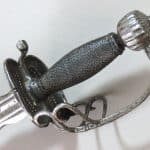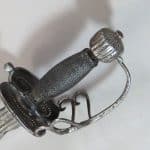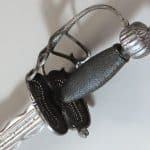
English Civil War / Restoration Period Officers’ Walloon Sword mounted with a Flamberge Blade
To enquire about this itemplease click here
Price: £2,500
Ref: 42121664
Item Description
English Walloon Swords were mainly produced from the second to the fourth quarters of the 17th century. The pierced guard plates which are typical of the hilt design were influenced by earlier developments in Europe, which were combined with the features of existing English sword styles, to create this unique form of English hilt. This sword is a rare example of an English sword mounted with a Flamberge, or “Flame”, blade where a broadsword blade has been delicately filed and thinned by the bladesmith with alternating crescents on each side of the blade descending in size to the tip in proportion with the taper. The fine construction of this sword indicates it was made for an English military officer.
English Walloons provided a stylish alternative to the other sword patterns that were in use throughout the English Civil War period, the Restoration period, and in the battles fought during the Glorious Revolution of 1688 when James II was deposed. Most usually these are cavalry swords mounted with single edged blades. Some English rapiers were also clearly influenced by the Walloon style.
The Flamberge blade of this sword is 30 inches long and has a bold central fuller extending from the hilt for 7.5 inches (19 cm) with narrower fullers either side for the same length. In bold capital letters the bladesmith’s mark ANDRIA FERARA is chiselled inside the middle fuller on each side with the letters interspersed and highlighted with patterns of dots. Beyond the fullers on each side three Man In The Moon masks have been stamped.
Flamberge blades were a European fashion of the 16th and 17th centuries. They are rare because of the skill and expense required to make them. To avoid weakening the blade the bladesmith had to ensure that when the crescents and grooves were applied a uniform width was achieved in proportion with the taper of the blade. Any functional reason for the Flamberge effect is still debated. The most popular explanation being that when used and dragged along an opponent’s blade it created vibrations which gave the user and advantage. Whatever the explanation it is clear that such a blade reflected the wealth and standing of the owner.
The hilt is made up of slender rounded bars built upon a sturdy quillon block. The cross bar is extended into a rear quillon which terminates in an upward hexagonal knop. To the front, the quillon is extended into a knuckle bow, the flat grooved terminal of which is tucked into an aperture located at the front lower part of the pommel.
Robust oval ring guards are mounted on each side of the cross bar, each with decorative knops shaped into the outer middles. Each ring is filled with a slightly downwardly convex plate, intricately engraved and pierced.
The plates are integral in the manufacture of the ring guards rather than of separate manufacture sprung into place in grooves chiselled around the insides of the rings. The sprung plates are a later European development rarely present on English swords of the time.
The knucklebow has two subsidiary scrolled bars emanating each side from just below halfway which splay and conjoin with the edges of the ring guards to strengthen the hilt structure. The hilt floor has a raised platform on the inside which supports the grip, and integral rounded langets emanate from the cross guard below on each side of the blade. The stylistic influence of contemporary English “Mortuary” hilts on these features is apparent. The cylindrical pommel has deeply fluted sides with an integral raised button on top and a flared neck beneath. The slightly baluster shaped wooden grip is bound with twisted wire and mounted with wire woven Turks Heads top and bottom.
The overall length of the sword is 35.75 inches (90.5 cm).
For further information on English Walloon swords, and to see similar examples, see Stuart C Mowbray, “British Military Swords – Volume One: 1600 to 1660”, Mowbray Publishing, 2013, pages 246 to 254. See also for further discussion, Cyril Mazansky, British Basket Hilted Swords, Boydell Press 2005, Chapter 11, pages 281 to 284. The swords are described as “Hilts based on pierced side rings”.

